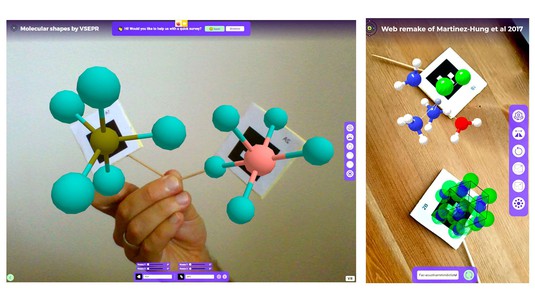Augmented reality helps chemistry and biology courses

© 2020 SPE-EPFL
How do chemical bonds form? Can we relate the energy and distribution of electrons to physical and chemical properties of molecules? How do proteins bind DNA to read its genetic information? To answer such questions and explore these phenomena, some imagination and abstract thinking was needed so far. This is why EPFL developed a platform based on augmented reality where EPFL professors, high school teachers and students can manipulate atoms and molecules in real time.
In addition to the illustrations found in chemistry and biology textbooks, teachers often use plastic-made models that help visualize and think about the spatial organization of atoms and molecules. Unfortunately, these tools cannot be used to represent other objects such as atomic orbitals or very large molecules. To fill in this gap, EPFL launched a web platform freely accessible on regular laptops, tablets and smartphones.
No virtual reality glasses or expensive licenses are required to use this tool. Users simply have to print out a few figures on paper, then manipulate them in front of the camera to be able to handle the molecules and make them interact: "I really enjoyed discovering the structure of known molecules such as caffeine or nicotine and trying to bind proteins to DNA", explains a high-school student who had the chance to test a preview of the website during a science day organized by EPFL’s Education outreach department at the Lycée cantonal de Porrentruy.
Among the activities proposed by Dr. Luciano Abriata, teacher at EPFL, and Fabio Cortes, webXR engineer, both developers of the project within the laboratory for biomolecular modeling led by Prof. Matteo Dal Peraro, there is also the possibility of experimenting with dynamic equilibria and hydrogen transfers, and testing the interactions between molecules: “We are looking forward to seeing how teachers and their students will take advantage of the platform, and even create their own activities as needed for their lessons”, explains Dr. Luciano Abriata.
https://molecularweb.epfl.ch/index.html
Contact: Luciano Abriata






F Cortés Rodríguez, G Frattini, L Krapp, H Martinez-Huang, D Moreno, J Salomón, L Stemkoski, S Träger, M Dal Peraro and LA Abriata. MoleculARweb: A Website for Chemistry and Structural Biology Education Through Interactive Augmented Reality out of the Box in Commodity Devices ChemRxiv 2020





